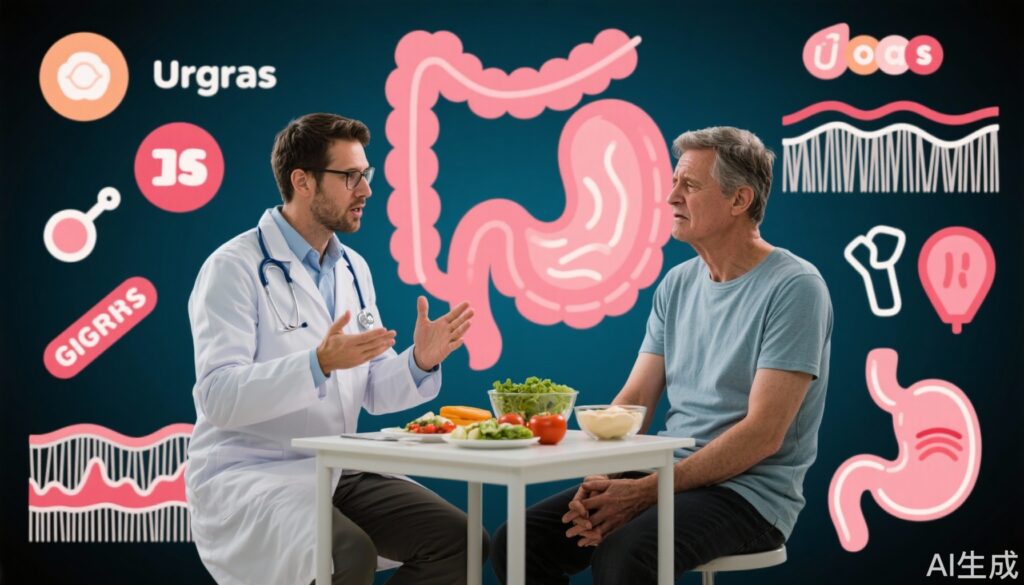Highlight
- A 6-week low FODMAP diet (LFD) significantly improves symptoms in patients with functional dyspepsia (FD), particularly postprandial distress syndrome (PDS).
- Symptom relief on LFD is not associated with measurable changes in duodenal mucosal integrity assessed by transepithelial electrical resistance (TEER) and dextran flux.
- Blinded powder reintroduction reveals diverse individual FODMAP triggers; mannitol is the most common, but glucose surprisingly triggers symptoms in a subset (27%).
- These findings underscore the importance of personalized dietary management in FD beyond standard low FODMAP restrictions.
Study Background and Disease Burden
Functional dyspepsia (FD) is a common gastrointestinal disorder characterized by upper abdominal discomfort and meal-related symptoms, including epigastric pain and postprandial fullness, classified clinically under postprandial distress syndrome (PDS). Despite its high prevalence and impact on quality of life, its pathophysiology remains incompletely understood. Emerging research suggests that increased duodenal mucosal permeability may contribute to symptom generation by facilitating luminal antigen penetration and immune activation. Nutrient-induced mucosal response is a key biological mechanism under investigation, with fermentable carbohydrates known as FODMAPs (fermentable oligo-, di-, monosaccharides and polyols) implicated in symptom provocation through rapid fermentation and osmotic effects.
Given that intragastric infusion of FODMAPs provokes FD-like symptoms, there is substantial clinical interest in the therapeutic potential of dietary FODMAP restriction. However, the distinct FODMAP subtypes responsible for symptom flare and their relationship with mucosal barrier function have not been systematically evaluated in FD. This study aimed to address these gaps by assessing symptom response to a low FODMAP diet (LFD) and subsequent blinded reintroduction of individual FODMAPs in patients with FD/PDS, alongside objective measures of duodenal mucosal integrity.
Study Design
This prospective study enrolled 36 patients fulfilling criteria for FD with predominant PDS symptoms. The intervention commenced with a 6-week low FODMAP diet, during which patients recorded symptom severity daily using the validated Leuven Postprandial Distress Syndrome (LPDS) diary. Additional patient-reported outcomes included the Short Form-Nepean Dyspepsia Index (SF-NDI) for quality of life, the Patient Assessment of Upper Gastrointestinal Symptoms (PAGI-SYM), and the Patient Health Questionnaire (PHQ) to assess psychological comorbidity.
At baseline and after LFD, patients underwent upper gastrointestinal endoscopy with duodenal biopsies. Mucosal integrity was quantified ex vivo by measuring transepithelial electrical resistance (TEER) and dextran flux assays, which reflect epithelial barrier function. Following the diet phase, a blinded reintroduction involved sequential challenges with 7 powdered carbohydrates representing different FODMAP subtypes: fructans, fructose, galacto-oligosaccharides (GOS), lactose, mannitol, sorbitol, and glucose (a non-FODMAP sugar control).
Key Findings
Post-diet analyses revealed significant symptom improvement: 73% of participants exhibited reduced LPDS scores, corroborated by parallel improvements in SF-NDI (quality of life), PAGI-SYM (symptom burden), and PHQ (mood symptoms). These results strongly support the clinical efficacy of LFD in this FD/PDS cohort.
Despite symptomatic relief, duodenal epithelial integrity assessments did not demonstrate significant changes in TEER or dextran flux pre- versus post-LFD across the entire group. However, individual patient-level analysis showed a positive correlation between improvements in TEER and symptom scores, suggesting subtle mucosal dynamic changes might associate with clinical benefit in some patients.
During blinded reintroduction, symptom recurrence was elicited by a broad spectrum of FODMAP powders, highlighting heterogeneity of individual trigger profiles. Mannitol was the most prevalent FODMAP inducing symptom relapse, implicating polyols as a key dietary culprit. Notably, 27% of patients reported increased symptom severity during glucose challenge, a sugar not classically categorized as a FODMAP, indicating complex or alternative mechanisms beyond FODMAP fermentability may contribute to FD symptom generation.
Expert Commentary
This study provides valuable evidence that dietary modulation via FODMAP restriction can be a practical intervention for FD/PDS symptom management. The finding that mucosal permeability measures remained largely unchanged challenges the hypothesis that barrier dysfunction is the overarching cause of FD symptoms or that it is reversed by dietary changes, at least in a short-term timeframe. Instead, symptom improvement may involve alterations in luminal substrate availability, microbial fermentation, gut-brain signaling, or immune modulation.
The discovery of glucose as a symptom trigger in over one-quarter of patients is particularly noteworthy. This suggests patient-specific factors such as intestinal glucose absorption, osmotic effects, or sensitization may drive symptoms. Clinicians should thus consider comprehensive and individualized dietary evaluation rather than universally applying low FODMAP principles.
Limitations include modest sample size and short follow-up duration. Further studies integrating microbiome data and longer observation are warranted to dissect mechanisms and optimize personalized nutrition strategies.
Conclusion
A low FODMAP diet elicits meaningful symptom improvement in more than two-thirds of patients with functional dyspepsia/postprandial distress syndrome but does not notably alter duodenal mucosal barrier function as measured by TEER and dextran flux. Blinded reintroduction confirms substantial inter-individual variation in FODMAP sensitivity, with mannitol as a frequent trigger and glucose unexpectedly implicated in symptom provocation. These insights advocate for individualized dietary assessment and re-challenge in clinical practice to tailor therapeutic diets. The complex interplay between nutrition, mucosal integrity, and symptom perception in FD requires further elucidation to refine non-pharmacological management options.
References
Van den Houte K, Broeders B, Tóth J, Routhiaux K, Mariën Z, Van den Bergh J, Vanderstappen J, Pauwels N, Meulemans A, Matthys C, Vanuytsel T, Carbone F, Tack J. Outcome of a FODMAP restriction diet with subsequent blinded reintroduction in functional dyspepsia/postprandial distress syndrome. Gut. 2025 Aug 28:gutjnl-2024-334156. doi: 10.1136/gutjnl-2024-334156. Epub ahead of print. PMID: 40876904.
Additional references to provide clinical context can be consulted in current gastroenterology guidelines and reviews on FD and dietary interventions.



